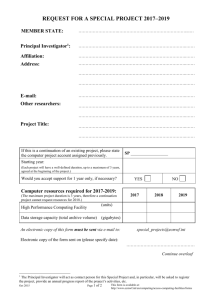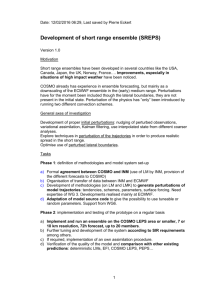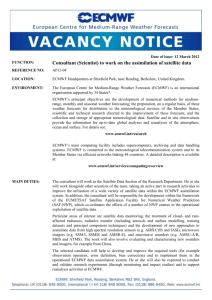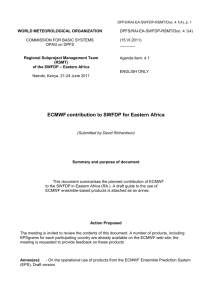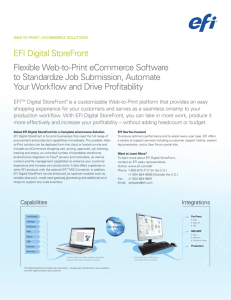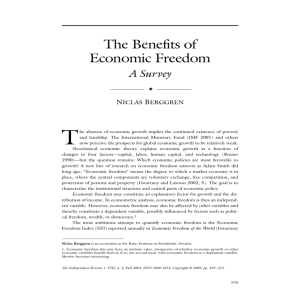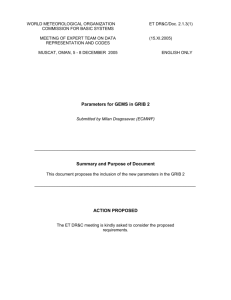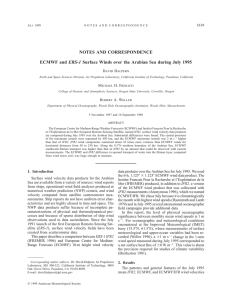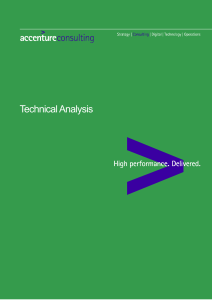EPS product development for Severe Weather at ECMWF
advertisement
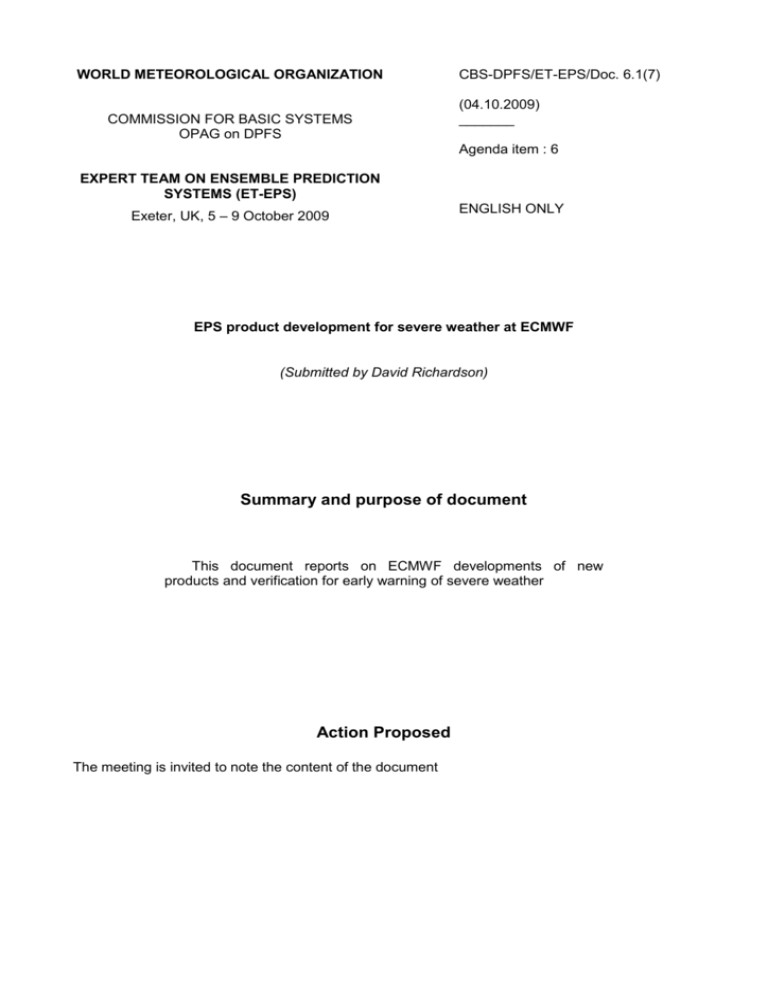
WORLD METEOROLOGICAL ORGANIZATION COMMISSION FOR BASIC SYSTEMS OPAG on DPFS CBS-DPFS/ET-EPS/Doc. 6.1(7) (04.10.2009) _______ Agenda item : 6 EXPERT TEAM ON ENSEMBLE PREDICTION SYSTEMS (ET-EPS) Exeter, UK, 5 – 9 October 2009 ENGLISH ONLY EPS product development for severe weather at ECMWF (Submitted by David Richardson) Summary and purpose of document This document reports on ECMWF developments of new products and verification for early warning of severe weather Action Proposed The meeting is invited to note the content of the document 1. Extreme forecast index (EFI) The Extreme Forecast Index (EFI) was developed at ECMWF as a tool to provide some general guidance on potential extreme events. By comparing the EPS distribution of a chosen weather parameter to the model’s climatological distribution, the EFI indicates occasions when there is an increased risk of an extreme event occurring. A new interactive web product based on the EFI is now available on the main ECMWF web site: http://www.ecmwf.int/products/forecasts/d/charts/medium/eps/interactive/globalefi/ The main page is an 'anomalous weather' chart that summarises EFI information for wind, temperature and precipitation. By clicking on a location on the chart, users can find more detailed information, including the distribution of EPS values for each EFI parameter. The 10- and 15-day EPSgrams for each location are also accessible; there is a new option to include information from the climate distribution on the 15-day EPSgram. Verification of the EFI has been performed using synoptic observations over Europe from the GTS. An extreme event is judged to have occurred, if the observation exceeds the 95th percentile of the observed climate for that station (calculated from a 15 year sample, 1993-2007). The ability of the EFI to detect extreme events is assessed using the Relative Operating Characteristic (ROC). Results are presented in Figure 1 for each season from winter 2004-05 to spring 2009 for precipitation, 10 m wind speed and 2 m temperature. For all parameters, there is a clear improvement during this period, especially for the 5-day forecast. Precipitation 10m wind speed 0.95 0.95 0.9 0.9 0.85 0.85 0.8 0.8 0.75 0.75 0.7 20 JJ 0 A 4 2 D 00 JF 4 2 J J 00 A 5 2 D 00 JF 5 2 J J 00 A 6 2 D 00 JF 6 2 J J 00 A 7 2 D 00 JF 7 2 J J 00 A 8 2 D 00 JF 8 20 09 0.98 0.96 0.94 0.92 0.9 0.88 0.86 0.84 0.82 0.8 D JF 09 08 D JF 20 08 20 A JJ 07 D JF 20 07 20 A JJ 06 D JF 20 06 20 A JJ 05 D JF 20 05 20 A JJ D JF 20 04 A JJ JF D 20 20 09 08 D JF 20 08 20 A JJ 07 D JF 20 07 20 A JJ 06 D JF 20 06 20 A JJ 05 D JF 20 05 20 A JJ 04 D JF 20 04 20 20 JJ A JF D 2m temperature 04 0.7 0.65 Figure 1: Verification of Extreme Forecast Index (EFI) for precipitation, 10 m wind speed and 2 m temperature over Europe. Extreme event is taken as an observation exceeding 95th percentile of station climate. Hit rates and false alarm rates are calculated for EFI exceeding different thresholds. Curves show the ROC area calculated for each 3-month season from winter (December-February, DJF) 2004 - 2005 to spring (March-May) 2009 for day 2 (light blue dashed) and day 5 (magenta dashed). Solid lines show running mean of seasonal scores averaged over 4 seasons for: day 2 (blue) and day 5 (red); last point is for average from summer (JJA) 2008 to spring 2009. 2. Extra-tropical cyclonic feature tracking In response to requests from Member States and Co-operating States, a range of products to identify and track extra-tropical cyclonic features is under development. A software package originally developed at the Met Office has been upgraded and implemented for the ECMWF forecast systems. This now runs in real-time and provides products on the ECMWF test web site. An example of two products is shown in Figure 2. The top panel depicts the 5-day deterministic forecast for 5 February 2009, showing the automatically generated synoptic features and a potentially strong wind storm. The bottom panel shows complementary information from the EPS: a strike probability map for a wind storm (defined as wind exceeding a threshold of 60 knots at 1 km altitude), which shows a high probability of this event occurring. This forecast verified as winter storm Quinten, which caused widespread damage to northern France from wind gusts of over 60 knots and disruption from heavy snow and flooding over England. Figure 2: Example of new extra-tropical feature tracking products. Top panel shows the ‘Automated synoptic chart’ at T+120 (00 UTC on 10 February 2009) for the deterministic forecast from 00 UTC 5 February 2009. Cyclonic features are marked by the coloured circles (green: diminutive frontal wave; orange: frontal wave; black: barotropic low) and warm and cold fronts are marked by red and blue lines respectively. Mean sea level pressure is in black. Weaker frontal features are denoted by smaller spots. Bottom panel shows the ‘Storm track strike probability plot’ for ±12-hour window centred on T+120 for the EPS forecast from 00 UTC 5 February 2009. Colours show the probability that a cyclonic feature meeting certain wind threshold criteria will pass within 300 km. The threshold used is that the 1 km wind, within a 300 km radius, must exceed 60 knots during the time window; this is called the ‘storm’ threshold. 3. Tropical cyclone genesis 4. SWFDP ECMWF continues to support the WMO Severe Weather Forecast Demonstration Project (SWFDP) in southern Africa by providing a set of forecast products for participating WMO member states on the ECMWF web site. ECMWF will provide a corresponding set of products for the SWFDP that will begin in the south-west Pacific later this year. A number of participants from these SWFDPs will attend the ECMWF training course on “Use and Interpretation of ECMWF Products for WMO members” in October.
